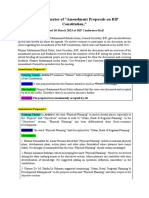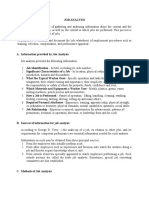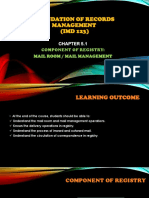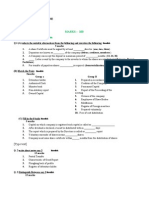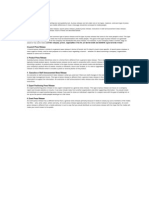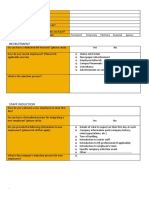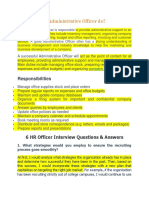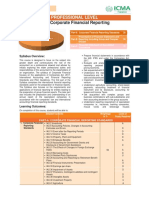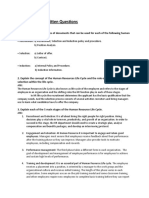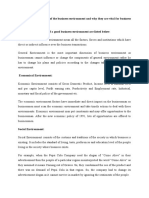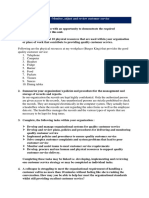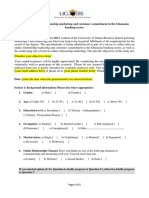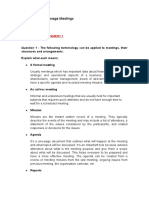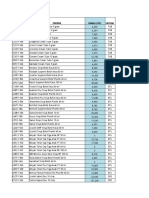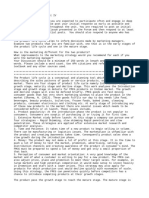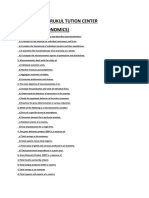How to write a report
Knowing how to write a successful report can make you a valuable asset in your current workplace or an
appealing candidate for new employers. Here are some steps to follow when writing a report:
1. Decide on terms of reference
Many formal reports include a section that details the document's "terms of reference" (or ToR). These
terms include:
What the report is about
Why it's necessary
When it was written
What its purpose is
Setting these terms helps both the writer and their readers to understand why the report is important
and what it hopes to accomplish. The terms of reference are usually explained in the first paragraph so
that the reader can determine their relevance without having to read the entire document.
Note: Setting concrete terms early on will help you create the report's outline and keep your discussions
on track throughout the report-writing process.
2. Conduct your research
Most reports will require you to collect a store of data that directly relates to your topic. You may
already have access to this information if, e.g., a doctor who has copies of a patient's medical charts.
However, if you're tasked with analyzing an issue and/or investigating an event, you'll likely need to
spend some time requesting, finding and organizing data.
Interpreting data and formatting it in a way your readers will understand and follow is an important part
of writing a report. For your report, you may need to create charts, graphs or timelines that make your
raw information easier to comprehend. You'll also need to carefully cite your sources and keep track of
where and how you found your report's data to present it professionally.
Related: Presenting and Arranging Data: How To Explain a Graph
3. Create a report outline
The next step in writing a report is to construct your report's outline. This typically looks like a bulleted
or numbered list of all the different sections in the document. Your report's outline might look similar to
this:
Title page
Table of contents
Introduction
Terms of reference
Summary of procedure
Findings
Analysis
Conclusion
� References or bibliography
The order of these sections—and whether you decide to include them all—depends on the specific type
of report, how long it is and how formal it needs to be. The most important thing to do when writing
your outline is to include all the necessary sections and eliminate anything that does not directly
contribute to the report's purpose.
4. Write the first draft
Writing the first draft of your report is one of the most important stages of constructing a successful
one. The purpose of the first draft is not to write a perfect document, but rather to get all the main
points of your information out of your head and onto the page. You'll have time to add to and edit this
first attempt, so your primary goal is just to organize your data and analysis into a rough draft that will
eventually become a final product.
While writing your report's first draft, you'll likely find gaps in your data or holes in your analysis. Make
note of these issues, but don't try addressing them as you write. Instead, finish the draft and save
problem-solving for when you begin the editing process.
5. Analyze data and record findings
The focus of every report is the "findings" section, i.e., the part where you present your interpretation of
the data. For an accountant, for example, the findings could involve an explanation as to why a
company's stock dropped the previous quarter. For an environmental scientist, the report's findings
could include a summary of an experiment on biodegradable plastics and how the results could affect
waste management methods.
The findings section should always provide valuable information related to the topic or issue you're
addressing, even if the results are less than ideal. If you conclude that the data was insufficient or the
research method was flawed, you'll need to explain this professionally and accurately.
6. Recommend a course of action
The final section of your report's body is your recommendation(s). After examining the data and
analyzing any outcomes, you're qualified to present an idea as to what actions should be taken in
response to your findings. For example, after reviewing the number of overtime hours their team's been
working, a project manager may recommend adding another member.
7. Edit and distribute the report
The final stage of writing a report is editing it thoroughly and distributing it to your audience. You'll need
to edit for grammar mistakes, spelling errors and typing mistakes.
You'll also need to double-check your data, make sure your citations are correct and read over the entire
document to ensure it presents a cohesive narrative. If the report is going to be read by a wide(r)
audience, you might decide to ask someone else to proofread it or give you their opinion on the
readability of the content.
�Distributing the report can take different forms depending on your particular occupation. You might
email it to your supervisor, present it verbally during a staff meeting or publish it in a journal. Regardless
of how or where it's read, your goal is always to create a concise, informative and effective document
that will contribute to increased productivity in your workplace.
Tips for writing successful reports
Here are some final suggestions to guide you on how to write a report:
Know your audience. Understand who the report is for, why they need the information and what you
want them to do after reading it. Knowing your audience will help you guide the style of your report and
ensure you communicate your information efficiently.
Proofread carefully. Nothing ruins a quality report quite like a missed typo. Before you submit or present
your report, be sure to proofread it carefully for any errors.
Be open to feedback. Depending on your job title, you may receive criticism or feedback on your
report(s). Try to remain receptive and open to critique. If you're willing to take feedback and implement
your superiors' suggestions, your writing will likely improve as a result.
Use your time wisely. Writing a quality report can take anywhere from a couple of hours to several
weeks. Before you begin, be sure to budget your time and set a regular writing schedule and/or daily
tasks to keep your progress on track.

